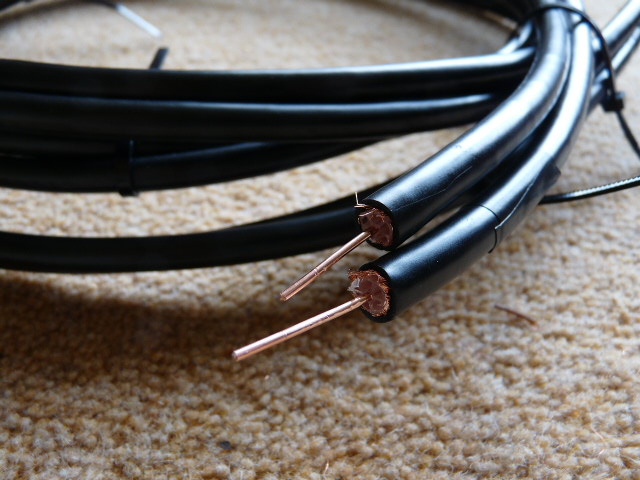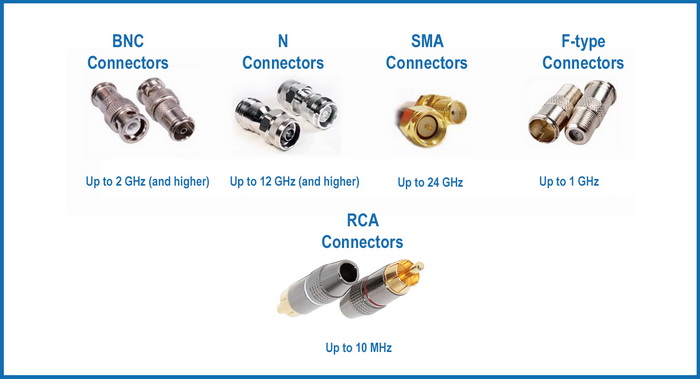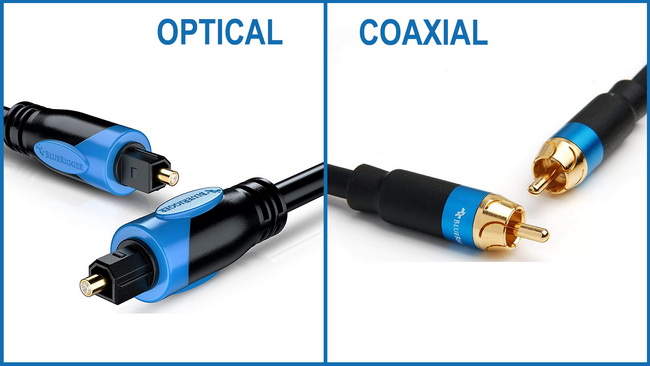Coaxial cables are used to send signals to televisions, antennas, and a variety of other devices, and the coaxial speaker cable is very similar. The difference is that it sends just audio signals to a speaker system. Let’s look at what coaxial speaker cables do and discuss how it differs from other types of cables you might use for your speaker system.
Here is the cable we recommend…

What Is Coaxial Cable?
Coaxial means that the cable was made by creating a shared axis between woven copper shielding and the cable core (or conductor). Because they have the same axis, this is what makes them coaxial.
This type of cable can send RF (radio frequency) signals from one device to another, connecting a destination device to an input device. The range of signals that can be transmitted through these types of cables include low infrared frequency waves, all the way up to the higher end of the audible spectrum. That’s encompassing 300GHz-20kHz.
These are incredibly common cables, and most speaker systems use them these days because of their reliability and usefulness.
What Does It Look Like?
These tend to be cylindrical cables that range in size from really thin to very thick (see Wikipedia). They tend to have a copper core, but they may sometimes have a copper plated steel core. This core usually has an insulator made from plastic, or a set of spacers with air between them.
The core will be shielded by silver plated braids or copper wire. Some cables, particularly those that are more expensive and considered high end, will have two kinds of shielding. That’s typically a combination of aluminium foil and braided copper. There are coaxial speaker cables with more shielding than that as well – up to four layers. However, this can reduce the flexibility of the cable, even though it boosts the performance, and decreases the risk of faults.
The outer layer of the cable is the jacket, and that’s most typically made from PVC or some kind of material that is designed to resist water, fire, UV light, or oxidation.
What are The Advantages and Disadvantages of Coaxial Cables?
There are several reasons why coaxial cables are preferred over other types of cables for most devices. The number one reason is because of how reliable they are. The powerful shielding in these cables protects them from interference (more information) caused by other signals, as well as electromagnetic disruption.
They also offer a wide range of signal utility, so they can be used to send high and low frequency signals.
A coaxial speaker cable transfer signals quickly, particularly compared to other kinds of cables. They can also send more information at once.
On top of all that, these cables tend to be cheaper than their counterparts, and their high quality, durability, and usefulness make them a great value proposition.
What kinds of disadvantages do these cables have, though? Well, by using just a single cable to send all the information, if one cable goes out of commission, the entire transmission goes down. It’s worth mentioning that some of the thicker cables, or those with lots of shielding can be quite stiff, making them harder to work with and set up.
Pros:
- Very reliable
- Relatively inexpensive
- Makes things simple with just one cable
- Transfers signals fast
- Low risk of signal interference
Cons:
- Single cable setup makes it vulnerable
- Some coaxial cables are very stiff
Different Types of Coaxial Cables
Coaxial cables are divided into different types based on how thick they are, what they are made of, how they are used, the connectors they have, and their impedance, or the current resistance.
Impedance is probably one of the most common ways they are categorized, with two types of coaxial cables offering 75Ω or 50Ω impedance, though some other impedance ratings are available as well. Most of the coaxial cables in people’s homes offer 75Ω impedance, which is mostly used for RF transmissions.
Here are some the basic categories that coaxial speaker cable can be broken down into outside of their impedance levels:
Flexible coaxial– This is the most common type, and it has a braided outer conductor that makes the cable really elastic so it’s easy to work with. These have the least amount of protection.
Semi rigid coaxial– This is a pretty strong cable that has an external conductor made of metal. These have stronger shielding but are less elastic than flexible cables.
Triaxial Coaxial– These have two exterior conductors that are separated by a dielectric sheet. One conductor is an earth ground, and the other serves as a signal foundation. Their working together improves noise resistance and insulation.
Dual Coaxial– This is two cables are covered by a single outer jacket.
Twinaxial– Two insulators having the same exterior conductor make up a twinaxial cable, and these are excellent for high-speed signal transfers.
What Kinds of Connectors Are Used for Coax Cables?
There are several types of coaxial speaker cable connectors. Let’s take a look at them:
SMA– The most common kind of coax speaker cable connector is the SubMiniature version A, and it works well with a wide range of frequencies. They are used in microwave devices, cell phone antennas, and broadcast antennas, of name a few electronics that utilize SMAs.
TNC– The Threaded Neil-Cocelman connector is a high frequency microwave connector.
BNC– This Bayonet Neil-Concelman connectors used in test instruments, television, and radios, and they work with low to medium RF ranges.

SMB– This is a version of SMAs that are tinier and can handle DC waves as well as signals up to the 4GHz range.
RCA– Radio Corporation of America connectors usually have a few colored wires that connect behind television sets.
QMA– These are made similarly to SMA connectors, but they detach and lock much faster.
MCX– These micro-coaxial connectors are super small and are used for devices that may not have much space to work with. They are most often use in cell phones and can accept and transfer signals between the ranges of 6GHz and DC.
7/16 DIN– The longer name is Deutsches Institut für Normung (see https://www.iso.org/member/1511.html), and these connectors able to handle incredibly high wattage signal transfers, making them very useful for military applications as well as for cellular networks or any network that uses multiple transmitters.
| Cable Type | Core diameter | Outer diameter | Impedance | Use |
|---|---|---|---|---|
| RG-6/U | 1.024mm | 6.86mm | 75Ω | Cable TV, satellite TV, cable modems |
| RG-6/UQ | 1.024mm | 7.57mm | 75Ω | Same as RG-6/U but with better shielding |
| RG-7 | 1.3mm | 8.13mm | 75Ω | Same as RG-6/U |
| RG-8/U | 2.17mm | 10.3mm | 50Ω | Amateur radio |
| RG-8/X | 1.47mm | 6.1mm | 50Ω | Same as RG-8/U |
| RG-11/U | 1.63mm | 10.5mm | 75Ω | Same as RG-7 but with lower losses |
| RG-58/U | 0.81mm | 5mm | 50Ω | Amateur radio, radio communications, Ethernet |
| RG-59/U | 0.64mm | 6.1mm | 75Ω | HQ HD video signal transmission over short distances |
| RG-60/U | 1.024mm | 10.8mm | 50Ω | HD cable TV High-speed cable internet |
What is Coaxial Cable Used For?
Coaxial speaker cables transfer sound signals from one device to another, transferring from a source to an input device. They can be used in surround sound or other speaker systems that might be plugged into your computer to television. Some types of coaxial cables are used primarily for satellite television or smart TVs.
What Is Coaxial Digital Audio Cable?
Digital audio cables transmit audio signals with an impedance of 75Ω and have RCA connectors. These cables can send wide range of frequency signals to connected devices, and they provide all the functionality of multiple cables in one. Digital coaxial cables differ from analog RCA cables in their impedance levels and output.
They also offer support for Dolby Digital (as high as 5.1) and can handle uncompressed 2-cahnnel PCM audio and DTS. They won’t support other types of DTS or Dolby formats, though, and they offer no support for multichannel audio.
Digital Optical (TOSLINK) VS Coaxial Digital Audio Cable?
Which of these two cables are the better choice? Some devices have optical and audio cables that are separate from one another, whereas others bundle both together in the same cable. What separate optical cables from coaxial ones?

These two kinds of cables are visually different. They are constructed differently and have different connectors. They even function in different ways.
Optical cables don’t have the solid copper core of coaxial cables. Instead, they contain optical fibers and send light rather than electronic signals. This light travels in pulses between the input device and the destination.
Coaxial cables offer a wider bandwidth range and very high-quality audio compared to optical cables. Does that make a difference in how good the sound quality is with coaxial cables? Not really, as you probably won’t even notice a difference in the sound.
One of the big differences between these two cables is when you should use them as relates to the distance between your input and destination devices. Optical cables work best for short range transmission, whereas coaxial cables are ideal for longer distance.
Which one is more durable? The coaxial cables should last longer and be able to handle more wear and tear than the more delicate optical cables.
Can Coaxial Cable Be Used as Speaker Cable?
Coaxial cables work very well for speakers, and there are a number of high-quality coaxial speaker cables available from major electronics brands. Coaxial speaker wire is excellent from transmitting high quality audio signals from your input device to your speakers- whether that input device is a computer, laptop, tablet, or television.
There are some advantages and disadvantages of using a coaxial speaker cable as opposed to other kinds of speaker cables. Let’s take a look at some of those.
Advantages and Disadvantages of Coaxial Speaker Cable
Speaker wire tends to be pretty cheap, and coaxial speaker cables used as speaker wires are a more expensive option. They are also bulkier and not nearly as flexible as thin speaker wires. After all, the coaxial cables have a lot of components inside their PVC coating.
| Advantages | Disadvantages |
|---|---|
| Affordable | One cable failure brings the entire network down |
| Easy to install and expand | Has to be grounded |
| Durable | It can be thick and stiff, which makes the installation much harder |
| Resistant to EMI and RFI | |
| Enables high-frequency applications | |
| High-bandwidth transmission | |
| High transfer rates |
Another disadvantage is their capacitance. Coaxial cable stand of have a higher capacitance than speaker wires, so there is a higher risk of instability, which is exacerbated with longer wires. We have already talked about electronic interference with these kinds of wires, though, and even though there is some risk of interference or signal failure, it’s still very low.
What kinds of advantages are there to using coaxial cables? They are better for sound quality than something like a parallel speaker wire setup. They also have allowed induction and excellent shielding. The shielding helps protect your transmission from interference caused by other devices and their signals, like radio interference.
Is Coaxial Speaker Cable Worth It?
Should you go with a coaxial cable over a normal speaker wire? While there are some minor advantages of using a coaxial cable for your speaker system, those advantages don’t really make the higher price tag worthwhile. If you think the subtle differences are really worth it, then by all means go ahead and use coaxial cables, but for most people, there is little to justify the price tag of choosing coax cables over conventional speaker wires.
Some people prefer coaxial cables, however, particularly the highly rated Mogami cables. These particular cables may improve your audio system, and they aren’t incredibly expensive like some of the other coaxial cable options out there. There isn’t any need to spend a lot of a coaxial cable setup, though, if the difference in sound quality will be negligible.
Can I Make a Coaxial Speaker Cable on My Own?
If you are interested in making your own coaxial cable for your speaker, you can do that using one of the many DIY instructional videos and articles found online. Just be aware that some of the tutorials are a lot better than others. Some are so short that they leave out key details, and some are so long that they will confuse you with their endless detail.
It may not be worth your while to make a coaxial cable for your speaker at home. It’s probably going to be a lot of extra work with very little payoff, but if you want to try to make it for yourself, then by all means, go for it.
We hope you found this extensive guide on the coaxial speaker cable worthwhile. It’s helpful to know the difference between the coaxial cable and other types of cables that could be used for your speaker or other device, if for no other reason than to help you understand why you might want to use one rather than the other. If we missed out on some important information somewhere or you found this helpful, please reach out and let us know.
Last Updated: June 27, 2022

























